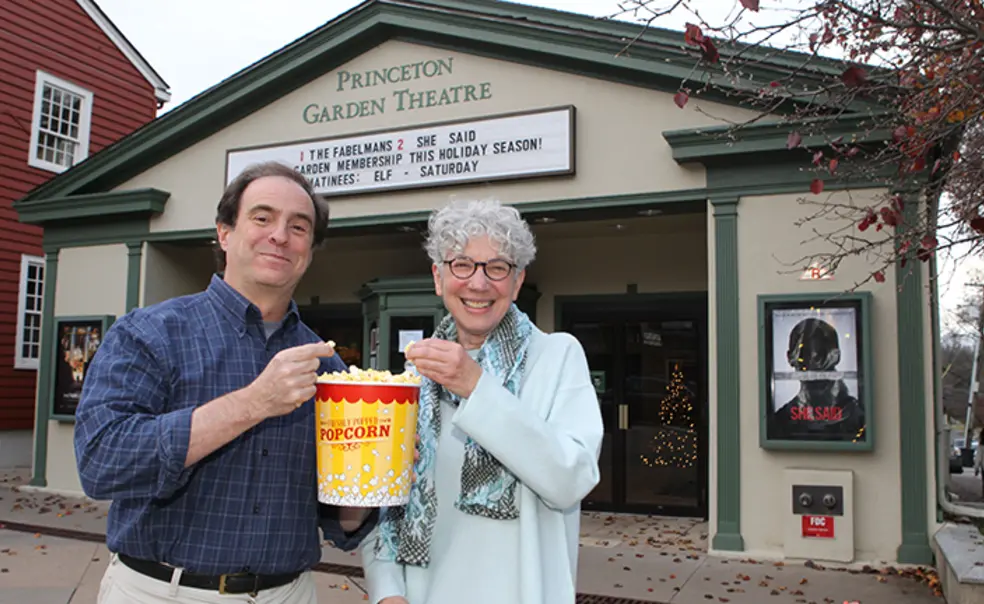PAW Goes to the Movies: Dean Jill Dolan Watches ‘She Said’
‘This movie tries to honor this moment of feminist resistance to male power, as well as making heroes of the reporters’
There is a Hollywood genre of newspaper exposé movies: think of All the President’s Men (Watergate), The Post (the Pentagon Papers), and Spotlight (sexual abuse in the Catholic Church). To this list add She Said, which covers the investigation by New York Times reporters Megan Twohey (played by Carey Mulligan) and Jodi Kantor (played by Zoe Kazan) of Hollywood producer Harvey Weinstein for sexual misconduct committed over several decades. The pair won a Pulitzer Prize for their reporting, which contributed to Weinstein’s subsequent conviction and imprisonment. She Said is written and directed by women.
For our latest installment of PAW Goes to the Movies, senior writer Mark F. Bernstein ’83 invited Dean of the College Jill Dolan to see the movie and discuss it afterwards. Dolan is also a professor of English and theatre and performance studies in the Lewis Center for the Arts, as well as a blogger, theater critic, and the author of seven books on theater, gender, and sexuality. She was the first blogger to win the prestigious George Jean Nathan Award for Dramatic Criticism in 2011.
MFB: What did you think?
JD: I thought it was terrific. The heroes of these newspaper reporter movies are typically men. It was wonderful to see a team of female reporters and how their characters changed the story. We see them at home, we see them with their children and husbands. We see them experience the work-versus-life tension in interesting ways. It’s wonderful, for example, that the two reporters first bond over having difficult first pregnancies and their general lack of sentimentality about motherhood.
MFB: How did the filmmakers approach this story differently than in those other newspaper movies?
JD: This story is different because it’s about the costs of sexual assault and harassment on women and about the women who tell the story of Weinstein’s abuse of his power. But the filmmakers could have told it as a straight newspaper reporter hero story, nonetheless. So the choice to include so much of these women’s personal lives and even to layer and texture the relationship between them was a great opportunity to think about the ways in which they work in a place that has its own history of gender imbalance as well. At one point, Carey Mulligan’s character asks, “Why should we do this? It’s just a story about Hollywood actresses and who will care?” and Zoe Kazan’s character explains, “It’s a workplace issue.” I thought that was a deft touch.
MFB: One of the early scenes covers Twohey’s coverage of Donald Trump’s sexual misconduct during the 2016 presidential campaign. There is even a scene in which we hear Trump berating her over the phone. Why did the filmmakers decide to include that?
JD: I imagine in part because those scenes put the story of the #MeToo movement and the Weinstein case in a broader political and historical framework. Later in the film, Twohey is uncertain whether she wants to work on the Weinstein story and says, “I wrote these stories about Trump and the man was elected anyway,” which neatly questions what power reporters actually have at this moment in history. These reporters’ stories about Weinstein, of course, helped ignite the #MeToo movement.
MFB: This movie differs from the other newspaper movies in that we also see a few flashbacks to the victims rather than focusing solely on the reporters trying to break the story. Why do you think they did that?
JD: Clearly, Twohey and Kantor are the heroes of the story here, but in a very different way than in, say, All the President’s Men. This movie tries to honor this moment of feminist resistance to male power, as well as making heroes of the reporters. One of the postscripts at the end of the movie says that 82 women eventually came forward against Weinstein. In a sense, those women are the real heroes, in terms of changing workplace culture.
MFB: There are a few scenes involving Lanny Davis (played by Peter Friedman), a lawyer who has been a Democratic Party activist but, in this case, worked for Weinstein. What did you think of those?
JD: When Davis meets with the reporters, he presents himself as someone trying to be a “good guy,” but he is also trying to protect his client. He’s an apologist for Weinstein, telling the reporters that Weinstein’s conduct was generational, that he just didn’t understand the rules, and so on. In this case, screenwriter Rebecca Lenkiewicz took a character and a moment that could have been presented as black and white and made Davis and his engagements much more nuanced.
MFB: Are there other ways in which this movie breaks the mold of those other newspaper movies?
JD: We see women listening to one another with empathy and care. The reporters often ask each other or the women they’re interviewing, “Are you OK?” Those other newspaper films were about the power of the reporter. Here, Twohey and Kantor know keenly what they’re asking the women they interview to do in going on the record against Weinstein, and what the cost and consequences will be. The screenplay doesn’t preserve the same separation between reporter and subject. Twohey and Cantor even ask each other if they’re sorry they wrote the story. You’d never see that ambivalence from Woodward and Bernstein.
Watch the trailer for She Said:












No responses yet